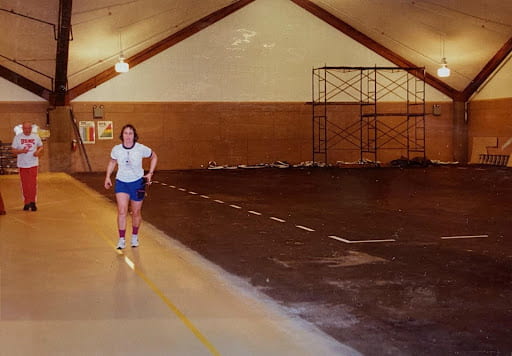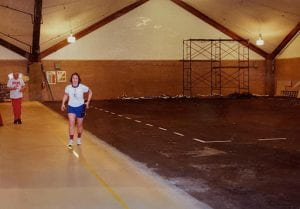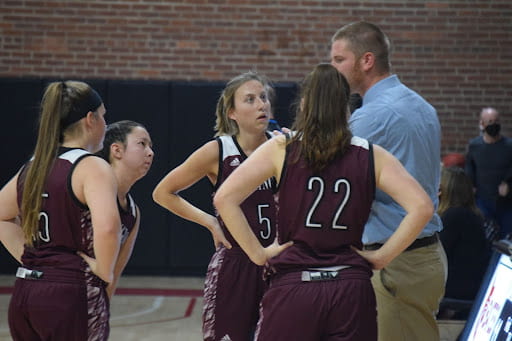
Dec 16, 2021 | Exclusive, Feature, News, Sports, TopStory |
By Michael Levesque, assistant editor and staff writer
This spring marks the 30th anniversary since the Fitness and Recreation Center (FRC) opened its doors to UMF and the community.
Since the building’s first official day on April 27, 1991, a lot has changed. Among these changes are the students and community members who use it, the staff who keep the building functioning, and the equipment inside. Noticeably missing from that list is the building itself. The Fitness and Recreation Center today greatly resembles the building that was made almost 30 years ago. “This office here used to have lockers where the group fitness instructors would change but it also had the director, the assistant director and the administrative assistant,” says Linda Blodgett as she gestures around the room her office is in. Blodgett has been working at the university since 1989. In 2001 she moved from the business office, where she started, to the FRC. “I was in the business office, it didn’t look like it does now,” said Blodgett. “Coming down here was much more comfortable for me – I haven’t regretted it. I have been on this campus for 32 years and I just love working down here.”
The familiar sight of the FRC has created an intimate atmosphere that many students and community members have come to value. “What I love the most is the sense of team camaraderie,” said Danny Terhune, a student and Physical Education instructor at the FRC. “[I love] the staff as a whole, you truly feel seen.”
“We’re such a unique facility, where the community comes in here and it’s really kind of neat,” Blodgett added. “Our staff that works here gets to know the community members and they see them outside of this place and our community members are always greeting them. It makes the students feel at home. It’s really really nice.”
Since the building’s erection in 1991, the building has adapted to the fitness and recreation needs of the community members. One year after the building was first opened to the public, the pool was installed. “Fitness is always evolving,” says Blodgett. “Body building was big back then. Group fitness was [also] really popular. Now it’s evolving into strength training.”
In order to meet the ever changing needs of the members of the community, constant work and refinement is done to the equipment within the FRC – with a cost as well. “There’s a lot of challenges,”says Blodgett, “the price of equipment is going up…[as well as] the maintenance of it. The cost of maintaining this equipment is a lot. There’s not a lot of companies around here that maintain equipment.” The COVID-19 pandemic has also contributed to the challenges at the FRC. “Trying to keep our membership up [is a challenge]. Our outside members, not just the students… are huge,” Blodgett says.
Even as the challenges continue, many in the community still treasure the building and the community with it. “I hope this place stays here forever,” says Blodgett. “I just hope that UMF… realizes how much this facility means to the people – students and community members… I hope it stays for the next 30 years because it is a great facility and it’s great for our students… You know, our students that work here learn so much about dealing with the public, it gets their confidence up. A lot of our graduates that work here say they haven’t found a facility they like more than here.”
“I love how I get to share my love of fitness with these coworkers as well as students in my class,” Terhune says. “This helps me as an education major really practice my skills as a teacher outside of my normal classes.”
Ben White, Director of Fitness and Recreation at the FRC, was pleased to announce some of the celebrations for the 30th anniversary coming in the spring. “A canoe race, mountain bike race, and 5k run” are all scheduled for the spring, according to White. As of right now these activities are scheduled for April 30th, 2022 – three days after the official 30th anniversary day. A reception will also be held later than afternoon. “The hope is that we get as many alumni back that we can that have worked here or that have gone to school here. I know a lot of alumni that went to school here that have never stepped foot in the building,” Blodgett says.
More details about the celebration in April are expected to be released on the FRC Instagram and Facebook pages as well as through their newsletter. The front desk at the FRC can be contacted at (207)-778-7495.

Community members inside the FRC prior to the completion of a basketball court. Photo courtesy of Linda Blodgett.



Construction on the Fitness and Recreation Center building. Photo courtesy of Linda Blodgett.

Dec 16, 2021 | Exclusive, Feature, News, Sports, TopStory |
By Page Brown, contributing writer

Nathan Carson speaks to his players during a free throw against Bates College on Nov. 16. Courtesy of Jacqui Hamilton.
UMF’s women’s basketball team is off to a strong start under the guidance of newly hired interim basketball head coach Nathan Carson. The squad, who is sitting at 5-2, saw key wins including winning the Castleton Invitational Tip-Off Tournament and the UMF Tip-Off Tournament in their opening two weekends of play.
Carson came into the program familiar with the players and program as he served as an assistant coach for the men’s program since the 2014-2015 season. Carson himself is a UMF graduate, graduating in 2014 with a degree in community health and playing for legendary UMF coach Dick Meader. While playing for the Beavers, Carson saw immense success, starting for three years and scoring 536 points, while maintaining a 77.6% free throw percentage and 36.5% three-point field goal shooting percentage. During his senior season, the team reached the North Atlantic Conference Men’s Basketball Championship.
The new coach hopes to bring his success to the team as the squad looks for a deep tournament run.
“The team is off to a strong start, we have had some gritty wins in the first half of our season. We love to get out and run and have fun, and I know that when we do that, we can be a dangerous team in NAC play.”
The desire to reach the playoffs comes to no surprise as the team returns 13 players, including all five starters from the 2019-2020 season that saw the team reach the championship game. The veteran led group is headed by a large senior class, thanks in part to the pandemic granting two players an additional year of eligibility within the National Collegiate Athletic Association.
Since the 2019-2020 season, the team has lost only four players: 2020 graduate Sara Lamb, 2021 graduates Halee Ramsdell, Kasey Talerico, and Chelsea Crockett. UMF forward McKenna Brodeur, a two-time first team all-star, looks to lead this year’s squad to a North Atlantic Conference Championship. She is joined by senior guard Alex Bessey, a second-team all star, and senior guards Makayla Wilson, Tia Day and senior forward Page Brown. Other key returning players for the Beavers this year include senior guard/forward Molly Folsom, junior guard Courtney Brent, and senior forward Cassidy Delano.
Yet the experienced group is also joined by a group of new players and coaches. Six players, Emily Small, Maddie Forgues, Kiely Renyolds, Jalyn Stacy, Jaycie Stevens, and Grace Woodman join the team. The group looks to make an immediate impact on the team, highlighting the talent on this years’ squad.
The squad was able to compete in only two scrimmages in the 2020-2021 season. However the 2019-2020 year saw the team going 14-14, culminating into a huge 70-63 win against conference foe Maine Maritime Academy in the NAC semi-final before falling to five time champion Husson University 70-60.
Dec 16, 2021 | Exclusive, Feature, News, TopStory |
By Jessica Gervais and Sophia Turgeon, Contributing writers
Most students that attend UMF are not aware that it is one of three schools in the UMaine system that have actual police departments as a part of their campus safety force. According to a 2019 survey released by the Association of American Universities (AAU), there is a 13% rate of nonconsensual sexual contact at colleges. This percentage is alarming.
Haley Sewell, sophomore at UMF, was at the Halloween dance hosted by the ACE club on 22 October with a large group when she witnessed an incident involving sexual misconduct. According to Sewell, she had been dancing with her group of friends in a circle when she noticed an individual had joined her group and began dancing inappropriately, touching other friends in the group. “Everything was fine at first, but then the student started getting out of hand,” Sewell said.
This incident went on for some time, even when Sewell was in smaller groups. The harasser would leave, but always return to make the girls uncomfortable. Moreover, they had made it obvious that no one was interested in the individual, but still, after all of this, the harassment persisted.
“We thought that he’d finally gotten the hint that he was making us uncomfortable, but he came back a little while later,” Sewell stated. “This time he was more aggressive in his approach. He continued to dance towards one of my friends, and this time reached out to grab her hips.”
Once this was happening, Sewell began looking out for her group of friends to make sure they were comfortable, even at times pulling girls away from him. “At one point we stopped for a water and bathroom break, where we heard from at least six other girls that the same student was humping, grinding, and groping girls. One girl even told us that her guy friend had to get between her and the individual and tell him to back off,” Sewell said.
After hearing this, Sewell and her friends decided to tell a chaperone, who was also an officer, exactly what had been happening during the dance. However, once the student was pointed out to the officer, he tried to weave through groups of students as an attempt to get away. Instead of being chased down though, the campus officer informed Sewell and her friends that he was going to back off and not engage. This decision angered the group. Why would one of our own campus officers simply back off and not stop this harassment immediately, they wondered.
After returning to her group of friends, Sewell said the harasser continued to follow her group around throughout the night, even at times targeting her directly. As the night progressed, the group lost contact with each other at times but finally joined back together to leave.
“After we left, we didn’t hear anything about what happened for about a month,” Sewell said.
According to Sergeant Wayne Drake, the department handled the situation correctly. In discussion, Drake said that he had followed the harasser and it was simply “poor bedside manner on the police department’s end.
In an interview with Brock Caton, the Director of Public Safety at UMF and the Police Chief for Farmington, Caton explained that in order for someone to be charged with anything, including sexual assault, there has to be “probable cause”.
“Probable cause” usually includes all elements of the crime in question. If there is “probable cause” present, then there are different ways that various crimes concerning sexual assualt are handled. This matter can sometimes include issuing a criminal summons forcing the person to appear in court and/or be arrested. Upon arrest, they’re transported to the Franklin County Jail to be booked. Once the booking process goes through, the case moves onto bail conditions along with other court proceedings later on. If the case goes as far as trial, the involved parties may be called to court to testify. Although most people bring along someone for support, the system prefers that interviews be done alone. The case being if they bring someone, especially another student along, the other person becomes a witness automatically in the investigation. This means they may be asked to testify in court. However, if the individual doesn’t feel comfortable being interviewed alone, the system will try to arrange the involvement of a Victim Advocate to be present and serve as support.
“… they (a Victim Advocate) will guide the complainant through the criminal justice process, to include assisting them with receiving resources and obtaining a Protection Order, if need be”, said Caton.
Thus, it can be extremely beneficial to have someone from Victim Advocate present for support if desired. If the complainant doesn’t wish for a person from Victim Advocate to be present, there is also the option of an informational brochure that is optionally provided. The brochure additionally provides information for the Victim Advocates just in case. All other witnesses will be interviewed alone in order to get the accurate and independent story version of what occurred in the incident.
For more information about the University of Maine Farmington’s safety department/Campus Police, go to https://www.umf.maine.edu/campus-life/campus-safety/
Dec 16, 2021 | Exclusive, Feature, News, TopStory |
Reese Remington
There’s a new club on campus making history with its formation. The Black Student Union (BSU) aims to create space for Black students- something that UMF hasn’t had before.
The BSU was founded by Junior Aman Hagos, who led three different BLM protests in Farmington last year. Hagos saw the need for a space for minority students to feel safe and seen.
This year’s freshman class is more diverse than ever before, and several Black students have confirmed Hagos’ feelings of a lack of space for Black students. Two freshmen on campus are excited to be a part of the change: Suki Fuzzell and Klaus Jacobs, originally from New York and Maryland respectively, came to UMF for the outdoors and a change of scenery from the city life. However, it hasn’t been a smooth transition.
Fuzzell recalls her time on campus as a minority as just okay. “I’ve had a couple of microaggressions here and there, but there’s nothing to do about it so you just keep going,” Fuzzell said. “However, I did drop my history class because it was kind of weird to be the only Black person in there and have them talk about slavery while being stared at so I dropped it for my own comfort.”
Jacobs shared a similar stance with their experience. “It’s been okay. Because I’m not as outgoing as other people it’s hard to make friends,” Jacobs said. “With white people sometimes they’re really close-knit – and that’s not a bad thing, but it’s hard to insert yourself into a close group. There have been people though who are understanding and can see that it’s hard being a Black woman on campus. It was a shaky start but overall good.”
Among other minority students on campus, the biggest issue Jacobs and Fuzzell have noticed at UMF is the lack of thoroughness and assertiveness towards racist events that take place. When asked if they believed UMF was inclusive, there was hesitation.
“I don’t think Farmington isn’t not inclusive but I think they could be a lot more inclusive,” said Fuzzell. “A lot of the issues that have happened with minority students have been brushed under the rug but if it’s a white student, it’s out in an email and everyone knows about it. It’s hard to not notice those types of things when there have been serious issues that aren’t being talked about.”
Jacobs and Fuzzell both agreed that Black students have a right to know what’s happening on campus, especially in regards to race.
“When you’re literally outnumbered by everyone on campus, your safety – it should be a top priority and sometimes it isn’t so you never really know what’s going on because you can’t prepare yourself for what’s going on if you don’t know,” Fuzzell said.
Despite the shaky start of the semester, Fuzzell and Jacobs both hope to see a difference by the time they are seniors, starting with the BSU.
“Honestly, I just want there to be more diversity by the time I’m a senior. I hope to see more cultural clubs that teach and celebrate different cultures – not just for us but for other students to learn about things that they might not really know because they aren’t taught about it here,” Fuzzell said.
Fuzzell also hopes to see more friends come out of the club. “When I came here, I was a little intimidated to go up to other Black students because they have been here longer than I have but having a club like this will open up that door and make it easier to find friends on campus that are other Black people instead of kind of feeling singled out,” she said.
Jacobs hopes for the same type of experience from a BSU on campus. “With a Black Student Union, it would be like having a little community – sometimes I need something for my hair or a product and I can’t ask my roommate or most of my friends so it’s little stuff like that, that matters.”
The Senate voted Monday, Nov. 1st, 2021 to make the BSU an official club on campus.
Dec 16, 2021 | Exclusive, Feature, News |
By Ashley Ward, Secretary and Assistant Editor
FARMINGTON 一 Over the next two weeks students at UMF will submit their final assessments and projects, bringing the Fall 2021 semester to a close. Finals are often a high-stress part of the school year for students, as they require a significant amount of effort and are typically worth a larger portion of the student’s final grade for a class.
Stress affects well-being in all aspects and mental health is just as important as physical health. For some students, their first experience with an academic final is in college and stress levels can skyrocket as a result. Sophomores Grayson Koelbl and Katelyn Ryan impart advice for any frazzled first year students:
“Remember to prioritize your mental health. This is easier said than done, because there are times when I don’t follow this. But have faith in yourself and make sure to check in with yourself mentally from time to time. Don’t forget, water is your best friend. Screaming into a pillow helps too,” Koelbl said.
“My best tip would be to really organize your time. Try to make a little schedule for finals week and the week before, making note of when you’ll be studying for exams or working on final projects and papers, as well as when you’ll be taking some time for yourself,” Ryan said.
Oftentimes, increased stress is followed by a lack of sleep as students scramble to find the time for everything they need to get done. Getting less than six to seven hours of sleep a night is not ideal and can lead to further stress-induced complications. Budget time to allow for sleeping/waking up at the same times every day, especially during finals week.
There is a hard cut-off deadline for turning in Fall 2021 assignments on Thursday Dec. 16 at 3:00 p.m.. Assessments or projects turned in after this point are not supposed to be accepted, so it would help to keep that deadline in mind when organizing your time.

Dec 16, 2021 | Exclusive, Feature, News, TopStory |
By Paige Lusczky, contributing writer
If you have taken a Physical Education class on campus, you are aware that it is a requirement to go to an extra class, outside of class hours, on Bystander Intervention Training hosted by the campus Step UP! Program. For a lot of new UMF students, Bystander Intervention Training is all they hear from the campus Step UP! Program. So, why is it such a big deal?
“Step UP! is a prosocial behavior and Bystander Intervention Program that educates participants to be proactive in helping others” as said by the National Step UP! Program.
UMF Step UP! Program advisor and UMF counselor, Gavin Pickering, said “UMF prides ourselves on being a supportive and caring campus” and “this program provides tangible procedures and action steps to support.”
“Students will become each other’s allies and have the confidence to go to parties or walk around campus knowing that there is someone in the vicinity who has their back and is willing to step in,” said the original proposer of the program coming to UMF, Professor Kathy Kemp.
The Step UP! Program not only promotes Bystander Intervention but also the “Seize the Awkward” campaign about reaching out to those who may be suffering from mental health and trauma. When the program was originally proposed as an Honors Enrichment Proposal with Kemp, it was written that “[UMF] needs to talk about violence, and be able to say the words rape, consent, and abuse, without a backlash of scoffing, head-turning, and eye rolls.”
The program has a large group of UMF student involvement but has unfortunately been pushed to the background because of the pandemic. “We have a lot of big ideas but we can’t do as much as we would like,” Pickering said.
You can mainly see student workers promoting it by tabeling or getting involved with Community Assistants and the resident halls. Currently, the Step UP! Program is also working with the Campus Safety Project to evaluate what else they could be doing.
Around Halloween, the Step UP! Program was tabeling to inform students on what type of Halloween Costumes would be considered cultural appropriation. With UMF sitting on Native American Land, it is important to promote respect for all cultures and not use them as a costume. Last year, the group tabled for National Women’s Day as well.
Pickering believes that it is important that students be involved in the Step UP! Program because “getting information from peers is more meaningful to students than being told by authority figures” and students “have to help each other too.” This is why Step UP! is even considered a work-study job opportunity on campus.
The campus Step UP! Program is a “challenge for people to change the culture,” Pickering said. Pickering believes for those who want to see change, the program is an “opportunity to pay students to implement change on campus.”
There are three work-study positions available, if interested, please contact Pickering at gavin.pickering@maine.edu or if you would like more information about the national program, please go to StepUpProgram.org.







